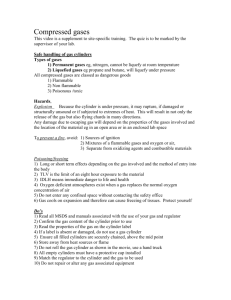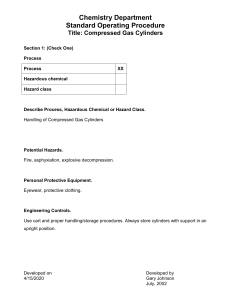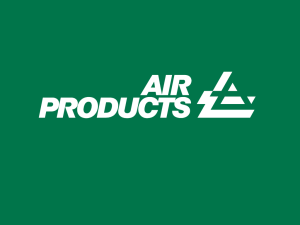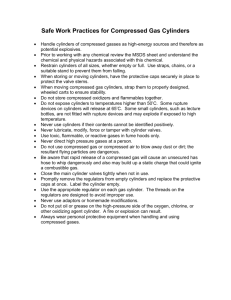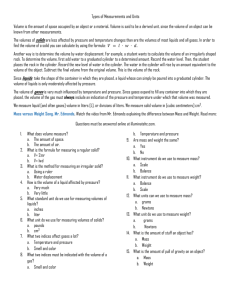Compressed Gas Cylinders
advertisement
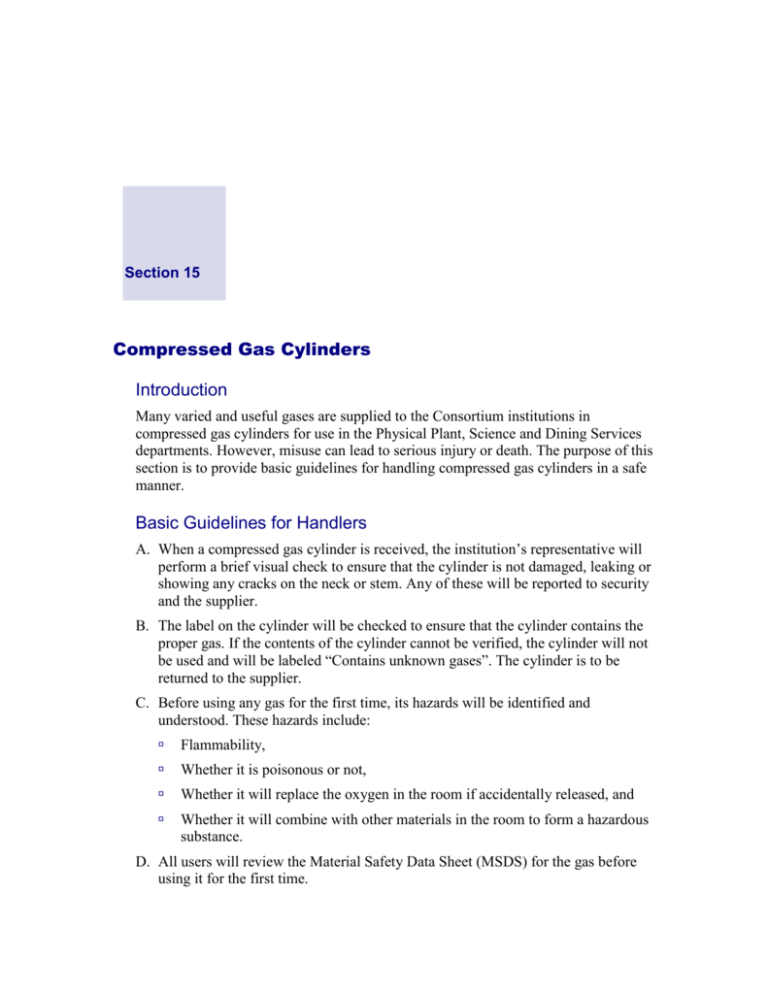
Section 15 Compressed Gas Cylinders Introduction Many varied and useful gases are supplied to the Consortium institutions in compressed gas cylinders for use in the Physical Plant, Science and Dining Services departments. However, misuse can lead to serious injury or death. The purpose of this section is to provide basic guidelines for handling compressed gas cylinders in a safe manner. Basic Guidelines for Handlers A. When a compressed gas cylinder is received, the institution’s representative will perform a brief visual check to ensure that the cylinder is not damaged, leaking or showing any cracks on the neck or stem. Any of these will be reported to security and the supplier. B. The label on the cylinder will be checked to ensure that the cylinder contains the proper gas. If the contents of the cylinder cannot be verified, the cylinder will not be used and will be labeled “Contains unknown gases”. The cylinder is to be returned to the supplier. C. Before using any gas for the first time, its hazards will be identified and understood. These hazards include: Flammability, Whether it is poisonous or not, Whether it will replace the oxygen in the room if accidentally released, and Whether it will combine with other materials in the room to form a hazardous substance. D. All users will review the Material Safety Data Sheet (MSDS) for the gas before using it for the first time. E. At a minimum, all users will wear sturdy shoes when handling cylinders, including shoes with safety toes when necessary. F. Users will always be sure to use a regulator with all cylinders of compressed gases, making sure it is the correct regulator for the gas in the cylinder. G. Users will ensure that the cylinder cap is always screwed onto the tank when handling, storing or transporting the cylinder, thus protecting the neck against accidental breakage. H. Users will wear appropriate personal protective equipment (PPE) when handling gases. They will refer to the MSDS for the gas to know what PPE is required. Cylinder Storage A. Cylinders will be stored in compatible groups. For example: Flammables away from oxidizers Corrosives away from flammables empty cylinders apart from full ones All cylinders away from corrosive vapors B. Oxygen cylinders are to be stored at least twenty feet away from combustibles or flammable gases, such as acetylene. C. If a twenty-foot separation cannot be maintained, a noncombustible barrier (at least one-half fire hour resistance rating) and at least five feet high is to be provided between the cylinders. D. All cylinders will be stored in an upright position in racks or secured with chains. This will keep them from falling over. E. Empty cylinders will be marked EMPTY or MT. Beware of “empty” cylinders, since once filled, a cylinder is never completely empty. Valves are to be closed on empty cylinders, to keep the remaining gas from leaking out. Empty cylinders are to be stored away from sources of heat and electrical wiring. F. Cylinders should be stored in defined locations away from elevators, stairs or other passageways. G. Assigned storage places should be located where cylinders will not be knocked down or damaged by passing or falling objects, or subject to tampering by unauthorized individuals. Cylinder Handling and Use A. A cylinder cart or dolly should be used to move a cylinder from one point to another. Using the connecting straps to ensure that the cylinder remains securely attached to the cart/dolly. B. Users will not drop, bang or otherwise abuse the cylinder. C. A protective cradle or secure hoist should be used to lift a cylinder, making sure to lift it from the bottom, rather than using the protective cap. D. The regulator should be removed and the valve protection cap secured in place before moving the cylinder, unless the cylinder is secured to a specially designed cart. E. The correct fitting is to be used to connect a gas line to a cylinder. If the fitting doesn’t set well, the connection will not be forced and where needed a new fitting should be used. F. Soapy water or other leak detection fluid should be used to check the tightness of connections, never a match or candle. G. Oil, grease and other hydrocarbon materials are to be kept away from valves, regulators and couplings. H. When opening a cylinder valve, the user will open it slowly and stand away from the face and back of the gauge. The user will open the valve to full open and then close it approximately ¼ turn. This will minimize the possibility that the valve will get stuck in the “open” position. I. Flashback arrestors and reverse-flow check valves are required when using oxyfuel systems for torch work. J. When a special wrench is used to open a cylinder or manifold system, the user will leave the wrench on the valve stem when in use. This will ensure that the wrench is always available to quickly shut off the gas supply in an emergency. K. No materials are to be stored on top of a cylinder, so not to damage the neck nor interfere with rapid closing of the valve in the event of an emergency. L. In addition to having an automatic gas shutoff, the system should also shut off automatically under conditions of high system pressure, high gas delivery pressure, loss of vacuum, loss of cooling or other conditions that could pose a hazard to the safety of the gas system. M. Areas where flammable gases are stored or used should be equipped with automatic sprinkler systems and smoke detector systems. These systems should be connected to the campus alarm system. N. Emergency eyewash stations and showers should be available in locations where corrosive gases are used or stored. These systems should be inspected and testflowed at least once a month with results documented. O. The exhaust fans should be connected to a source of emergency power to help clear the area of hazardous gases in the event of an emergency where normal operating power has been shut off. P. When done using a compressed gas, shut off the main cylinder valve first, then bleed off the regulator and lines and then close the regulator. The regulator should not be left under pressure by closing down the regulator without first shutting off the main cylinder valve. Poisonous Gases Some gases are poisons. Their use requires us to take special precautions. Because we have some poison gases in use on our campus [List locations here], we will comply with the following guidelines: A. The institution should identify which poison gases may be in use. Common poison gases include arsine (AsH3), ethylene oxide (EtO), hydrogen cyanide (HCN), nitric oxide (NO) and phosphine (PH3). The user will refer to the MSDS to ensure that everyone who may deal with the gas knows its hazards and preventive measures to use to prevent injury. B. When first ordering a cylinder of a poison gas, find out from the distributor how to dispose of the cylinder when it is empty. The distributor should be able to receive the empty cylinder back or be able to suggest someone who will take it. C. The institution should ensure that proper handling procedures are documented in their Chemical Hygiene Plan (refer to Appendix 14-A). D. Campus Safety and community first responders are to be notified of the location, type and quantity of poison gases so that appropriate response procedures can be implemented if necessary. E. Only trained and authorized users are permitted to use a poison gas. The Chair of the Chemistry Department maintains a list of authorized users. F. Certain poison gases (e.g., ethylene oxide) may only be used if specific OSHA regulations are followed. G. All laboratory fume hoods should be tested semesterly to ensure that they are exhausting air at the required ventilation rate, both before and during the time poison gases are being used.
